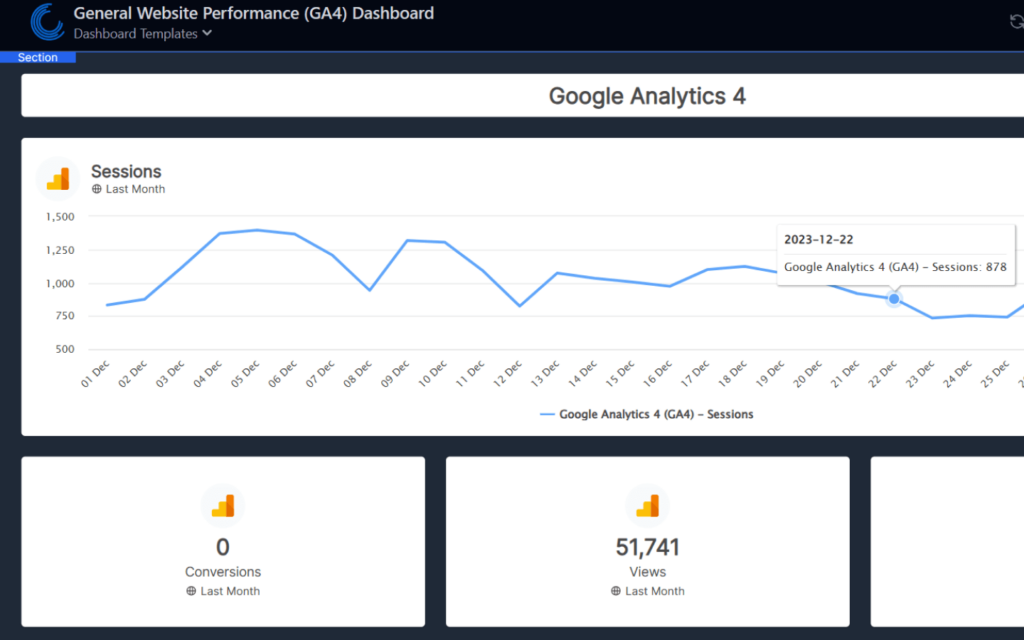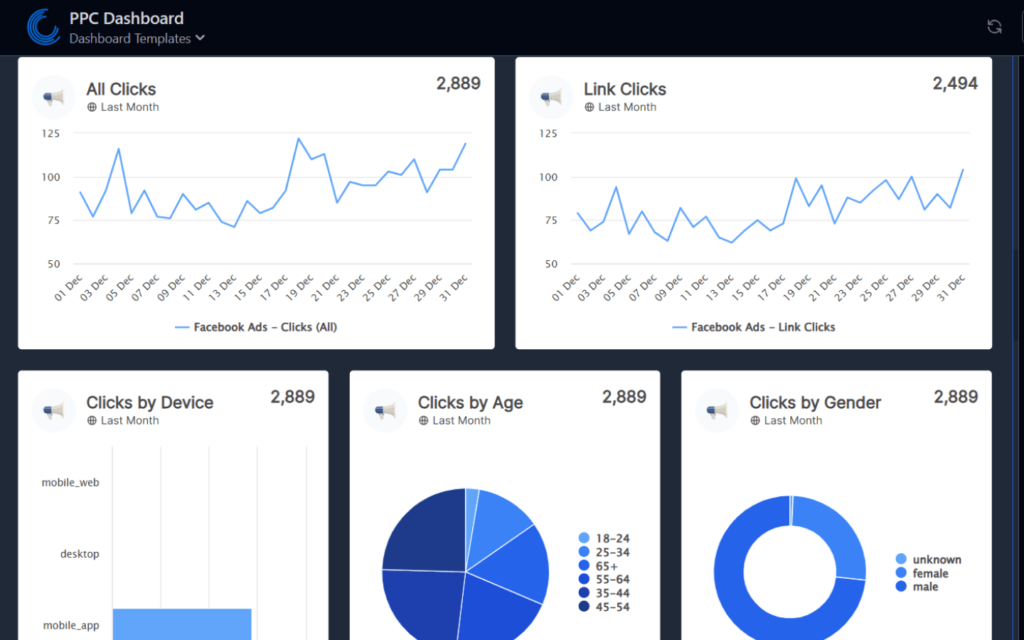Table of Contents
“We’re going to dive deep into digital marketing reporting today and look at how you can present the perfect digital marketing report to your clients or your boss.”
Digital Marketing by the Numbers: Data-Driven Strategies for Success
As we explain the importance of digital marketing reporting, we must remember that we live in an age of never-ending digital content production and availability. Whether it is being blasted into our faces from our mobile phones or we are passively absorbing a couple of social media updates on our laptops, we are spending more and more time online every day. More and more people are flocking to social media and the Internet to do their shopping, invest in companies, watch the news, and connect with friends and relatives. It is estimated that the average adult spends almost 7 hours every single day online – scrolling through social media, shopping, messaging and more.
As a result, digital marketing has exploded. On a global scale, digital ad spending reached an impressive $389 billion in 2023, significantly overshadowing the $234 billion allocated to traditional formats. This stark contrast highlights a decisive preference for internet-based platforms over traditional media, with digital ad spending accounting for 62% of the total.
However, like any form of marketing, in order to advance your digital marketing and its effectiveness, reach, and interaction rates, and most importantly return on investment, you need to be measuring the data that is readily available from your current and future campaigns.
We’re going to dive deep into digital marketing reporting today and look at how you can present the perfect digital marketing report to your clients or your boss. These reports are what retain clients or send them packing, helping to demystify all of the “analytics” related to the effectiveness of digital marketing today.
You can no longer post a picture or a quote and call it a day. There needs to be educated backing for each and every post, and that can only be made possible through digital marketing monitoring.
Despite experiencing its slowest growth rate in over a decade, digital ad spending in the U.S. in 2023 is still seeing a substantial increase, with nearly $20 billion more being spent compared to 2022. A key observation is that much of this new investment is flowing into emerging channels rather than the ones popular just a few years ago.
InsiderIntelligence
So, whether you’re the owner of a digital marketing firm, a digital marketing manager, or even a client looking to understand analytics better, we’re going to break everything down for you. Starting with the basics of a market report and what it should contain, then we’ll dive into four key questions to address in a briefing, ten sections that every market report should include, daily marketing reporting examples, and finally, best practices for your marketing firm or team moving forward.
Are you ready to get started? Without further ado, here is Digital Marketing Reporting Explained.

Chapter 1: What is Marketing Reporting and why is it important?
When it comes to preparing the perfect digital marketing report, it first requires a basic understanding of what the report actually is, and why it is so important. Before nuances can be explored and details can be broken down, the entire purpose of marketing reporting needs to be explored and explained to its fullest.
That brings us to our first question: what is marketing reporting?
Digital Marketing Reporting
At its core, marketing reporting is the process of measuring progress, showing value, and identifying actionable steps to improve marketing performance. The idea is to crunch the available numbers and analytics to help meet future marketing goals, whether that be earning more revenue, expanding service footholds, increasing the online audience, etc.
A digital marketing report can be broken down, generally, into the following structure, which we will explore in a coming chapter:
- Summary – Breaks down the key points, including successes, challenges, and upcoming goals
- Traffic Metrics – Top of the funnel acquisition numbers broken down by channel
- Engagement Metrics – Onsite activity and time spent on site before leaving
- Conversion Metrics – Cost per lead or acquisition so they can determine if they want to keep investing
- Business Impact Metrics – Opportunities, pipeline generated and revenue driven by marketing
Depending upon the types of campaigns that you are running, you will want your reports broken down for PPC, SEO, social media, content marketing, account-based marketing, revenue reports, and overall comparison reports.
Why is Digital Marketing Reporting important? Why do we go through the hassle of exploring the reporting of metrics generated through digital marketing? Why is it even important anyway? We’re glad you asked!
Let’s look at a few important reasons why building reporting into your workflow is critical to any thriving business today.
📊 Reports detail the actual efforts:
You already understand that marketing is important in our world. That’s why you work in marketing. However, your clients don’t share that same passion for marketing – they just know it’s a necessary evil. Marketing reports show them that your efforts are paying off. They articulate how campaigns are fulfilling goals, generating sales-ready leads, and bringing in revenue. That’s all these clients care about at the end of the day: is their investment paying off? If not, they’re probably going to walk away.
📈 Establishes a benchmark:
Marketing reports provide you with a benchmark for how things are working right here, right now. You can look at a report and go: are we succeeding? Where are we falling short? Where do improvements need to be made? Which channels are working and which ones are not? All of these questions can be answered with marketing reports that will act as a guide for you throughout all of your marketing efforts. Without these digital marketing reports, the team will be flying blind, aimlessly creating messaging and content that is totally falling by the wayside. That’s why digital marketing reporting needs to become a core part of your day-to-day marketing operations and workflow.
📅 Creates year-over-year review:
At the end of the year, when you’re sitting there reflecting on your business and how far it has come, you will want to see the bigger picture with your analytics comparison The goal should always be continuous growth for your company, which means every digital marketing report should be compiled. Which months were your slowest? Which days of the week? Did you do better around the holidays? These big-picture trends should be observed and highly noted for the coming year so you know to invest more money into your Christmas campaigns, etc.
👥 Makes it easier for segmented teams:
Digital marketing is a complex feat today. It involves photography and videography, copywriting, hashtag research, audience research, keywords, and the list goes on. At big digital marketing firms, these are all broken down into different departments, which means there needs to be cross-communication constantly. Analytics reports will help teams identify which component needs to be invested in more for an upcoming campaign. Perhaps photos are doing better than videos in your market. Only a digital marketing report will help you identify that in real time so the necessary departments can make changes.
🕑 Real-time information:
That brings us to our last and final point: the value of having real-time data at your fingertips. When you engage in marketing reporting, you are forcing yourself to go over the numbers every single month. With this information, you can make real-time changes and adjustments to campaigns to ensure they are more effective the next month. Why wait until the time of the year to review the necessary information when regular reporting can get it done for you? It’s up to you the kind of cadence you want for reporting the analytics – some people elect for weekly or bi-weekly updates as well.
If you get into the habit of understanding the importance of digital marketing reporting, you won’t find compiling the reports to be so monotonous anymore. As we hinted in this section, we are now going to explore what questions need to be answered before you finalize that marketing report.

Chapter 2: Four key questions to address in a briefing
Before you explore the nitty-gritty details that go into a digital marketing briefing, managers are going to be concerned with four general areas that are related to what they are doing on their end. Think about it from their perspective: they want to spend money on marketing so that they can make more money. Therefore, they want to know that their dollars are earning them more. They don’t really care how you do it – they just want to know their ROI is paying off.
This can be hard for those steeped in marketing to understand. To you, every last detail matters tremendously – as it should! But before you concern yourself with the details, you need to first concern yourself with the main four questions that should be thoroughly answered (and presented) in your digital marketing report.
Digital Marketing Reporting Explained: Four key questions to address in a briefing
- How much money is being spent?
- How many people are being reached with that money?
- How effective have marketing efforts been?
- What is the financial return on the money being spent?
💰How much money is being spent?
Sometimes, a company may give you X amount of dollars and tell you to allocate it however you see fit. Other companies will permit a fluctuation in what you can use if you have their card on file. Either way, they want to know how much money is being spent, and on which channels it is being spent.
Your digital marketing report should therefore cover things like Facebook Ads, prizes for contests and giveaways, SEO on your blogs, etc. during the reporting time. There should be a total dollar amount spent per digital marketing segment, as well as a total for everything at the end of the month. This won’t necessarily deter them or send them away – they just need to be able to identify what is being spent quickly to make better business decisions.
Takeaway: Clearly break out marketing spend by channel and tactic.
👥How many people are being reached with that money?
Now it’s time to look at a question that is a little more complex. The managers know what is being spent, the next question in their minds is going to be how effectively those dollars being spent. Should they be skeptical of you? Are you doing a good job, or are their dollars falling by the wayside?
Your marketing report should articulate the total reach of your efforts, also known as the number of people who have received your marketing message through social, email, etc. This should also cover website visitors, as well as where those website visitors can come. With these numbers, companies can start to decide if they want to continue on with your services and if they feel the investment is worth it. As we will review in the coming chapter, there are different sections in the report that can help you highlight your marketing value even if some numbers are lagging.
Takeaway: Quantify audience reach across owned, earned, and paid channels.
📈How effective have marketing efforts been?
This is where the client is going to expect some information on leads. Are leads being generated? Are they closing? Are they converting into numbers that translate into a higher bottom line for the client? Are these leads becoming customers?
Be sure to highlight in the report the number of new leads, or the people who received your marketing message and pursued your service/product further, as well as the number of new customers, or the people who went from being leads to actual investors in the business.
This is how the client will compare if the money being spent is translating into the results they want and desire.
Takeaway: Spotlight lead generation and sales conversion metrics.
💰What is the financial return on the money being spent?
Is it all worth it at the end of the day, or could the client go on their merry way and attempt their digital marketing on their own? The digital marketing report should cover the cost per lead and the cost per customer. What does it cost, at the end of the day, to turn one of the leads into a cold, hard, paying customer? Can you ramp up your efforts so your client can make more money?
Be sure your marketing report articulates this in an obvious way for the client. You have to remember that digital marketing monitoring is not their forte – that’s why they hired you instead!
Takeaway: Provide clear ROI indicators like cost per lead and sale.
“What does it cost, at the end of the day, to turn one of the leads into a cold, hard, paying customer?“
Chapter 3: What should a Digital Marketing Report contain?
When it comes to the actual creation of your digital marketing report, there are a handful of mandatory categories that every single report should contain. In order for them to pack the most punch, they need to list things in a way that is impressive, forthright, and also organized, helping anyone without marketing experience to scan the report for what they do/don’t want to see.
Although you might be more passionate about these reports, you have to keep in mind that the client’s impression is what really matters.
Starting with a summary and breaking everything down into the important details, here are the top 10 things that should be contained in every digital marketing report:
1. The summary page:
Before you hit someone with aggressive numbers, first, hold their hand and walk them through a nice summary or highlight page. This section should always be at the top of your report. In the summary, you want to highlight the most important metrics and a project overview that is succinct and to the point.
By the end of the summary, your client should have a general understanding of where their marketing stands and what the future goals are going to be after they review the report. Everything that comes after this section should be details that support this opening summary statement.
Since not everyone is a marketing expert, try and keep the jargon general and accessible so everyone is able to get the full picture.
2. Present marketing strategy:
Again, although you are probably well-versed in this marketing strategy, many of the executives and stakeholders are not. That’s why you want a section that approaches the core marketing strategy.
In this section, you will want to answer the following questions:
- Who is my target market?
- Which channels are performing the best? Are they also the primary marketing channels?
- What growth opportunities are being harnessed?
- What is the present scope?
This is an easy place for you to articulate to the client why they hired you. Take time to ensure the scope of the project is clear and that you are delivering everything you promised to the client.
Let’s say you are offering SEO. This is where you will give an overview of what SEO is and how you are leveraging your skills to boost your client’s SEO. Spell it out in obvious terms, even if you think it’s redundant. Be sure to reaffirm how you are reaching the target customers every single day, whether it’s more of a focus on blogs or on email – and why you are choosing those channels.
Wrap it up by giving an overview of what has been accomplished in the last month as far as the marketing strategy is concerned. You do always want to still sell yourself. Be sure to mention any changes to the marketing strategy and why you felt those changes were important. Close it by stating how the changes are going to improve effectiveness in the coming months.
As you can probably see, this section is arguably one of the most important in the entire report.
3. Conversion metrics:
Now that you’ve warmed the client up with some overviews and everyday jargon they can understand, it’s time to cut to the numbers every CEO wants to see: the conversion metrics. The conversion metrics should take up the meat of your report, with plenty of charts, graphs, and statistics that show how your campaigns are right in-line with growth goals and projections.
You will want to bolster this section up while also keeping it easy to understand. Run reports on metrics such as:
- Channel breakdown – leads by channel, offline sources, social media, paid search, etc.
- Revenue breakdown – this is especially important to those with e-commerce sites
- Paid vs. organic leads breakdown
- Cost per conversion for paid channels – how are your AdWords and Facebook ads doing?
It helps to compare the current metrics month to month so you can showcase where you have excelled and improved.
4. Lead acquisition:
If you are working with a company that is hot on leads, be sure to list out the leads that you have generated that month through digital marketing efforts. In this section, show which channel the leads were coming from, whether it was SEO or PPC, so your client has a clear picture of where their marketing investment is generating the highest returns.
5. Breakdown by channel and device:

At the end of the day, it is imperative to understand where your website traffic is coming from. You also want to know how long those leads are lingering before they either buy or leave. Are most of your web visitors coming from email? Referrals? Social media ads?
In this section, you will want the metrics to include:
- Bounce rate
- % new session
- Top pages
- Email campaigns
- Top Referrers
This is where you can show the client that the bounce rate is much higher on mobile than on the website, for example. With those numbers, the client knows that the mobile site needs to be altered or optimized for mobile viewing. You will also uncover blog posts that are doing much better than other posts – why? Was it the topic? Should you do more blogs related to that topic?
6. Search engine optimization:
This will vary depending on the SEO that your firm is offering. For example, do you optimize onsite, or do you just stick to providing link-building services? Either way, be sure to share an overview of how rankings have increased – then back it up with information about what you have been doing to achieve these results. Be sure to include a table that highlights new backlinks for the month.
7. PPC endeavors:
If you are tasked with running PPC campaigns for your client, be sure to have a section that covers the cost per conversion, click-through rate, impressions, ad spend, ROI, etc. Take the results and compare them to each channel. If the client is working with a limited budget, you can deliver value by making recommendations about where their money should be targeted using the information presented in this section.
8. Social media marketing:
Social media marketing is another component of this overall report, as well as strategy. There isn’t a single business out there that is unaware of how important social media marketing is today. In this report section, be sure to cover performance per channel, including Facebook, LinkedIn, Twitter, Instagram, and YouTube. Also be sure to show two important goals, like engaging existing customers and generating new leads via social channels.
Many companies will want to invest big money into social media marketing, which is why this section should be carefully detailed.
9. Ideas for the future:
Showing a client that you have future plans and goals is a great way to convince them to stick around with your services. This is a section where you can show off how much you plan to do so they are excited to stick with you for future months. If the past month’s analytics have been lackluster, here is where you can show them that you are going to continue pushing the boundary. Revisit goals from prior months and highlight any progress that has been made.
10. Future budget:
Last but not least, here is where you can chat about future promotional expenses that you are anticipating as well as the expected return on investment. This area should take the goals that you just listed and provide some kind of cost analysis associated with them, so your client doesn’t need to do anything but agree.
And there you have it! Those are the key components of any effective digital marketing report, sure to wow clients sitting across the table from you.
Chapter 4: Considerations for different marketing reports
The most complicated part of building marketing reports is that you need to include so many different channels in one scope. You are tasked with reporting everything from email campaign results to social media marketing effectiveness, which can make it hard to sort everything out all at once.
Although there need to be cross-comparisons so clients can make final decisions on the money they want to spend on your services, there are still some considerations you should be making based on the channel reported.
While the metrics may all be related, each channel source report should still have its own characteristics that make it a unique, standalone mini report. For example, in your SEO report, you shouldn’t have information on ads and quality scores, whereas, in the PPC report, you should most definitely have that information presented. But then there may be some similarities between SEO and content marketing, where you’re focusing on keywords that are helping with the total conversations and clicks.
When it’s time to create individual reports, you must take into account source differences. This will make you look more professional, and it will also help your client follow along with everything they need to digest in one sitting.
Although we can’t go through what should be included in every single individual report in this article, we will provide you with examples of SEO and PPC marketing reports.
SEO individual reporting

Your typical SEO report will contain the following:
- keywords performance
- landing page performance
- rank improvements
- increase in organic traffic
- conversions
- top-performing content
- improvements made to the content
- overall optimizations
- inbound traffic
- backlinks
- general overview of what it all means
Remember that the viewer is not also an expert on digital marketing like you are.
PPC individual reporting

With PPC, you will want to highlight that your efforts are driving more traffic and leads. Therefore, your metrics will take a different structuring, including the following:
- average position
- cost per click
- overall cost, clicks
- click-through rate
- impressions
- conversions
- overall conversion rate
- cost per conversion
- quality score
- keyword performance
- individual device performance
- overall PPC performance
With PPC, your client will probably request that you provide a weekly report as opposed to a monthly report. Yet, something like social engagements may only require your attention a few times per year.
Despite the differences, all reports should still contain a summary, as well as lessons learned, goals, and how you plan to reach those goals in the future.
That brings us to another hotly contested question in the world of digital marketing reporting best practices: how often should I generate reports?
The Magic Cadence for Digital Marketing Reporting
If there were a one size fits all answer to this question, we would provide it. However, there are always different elements and moving parts that should be considered with this kind of answer.
You will need to set expectations early with your client. Talk with them about how frequently they want to see reports. As the expert, you should tell them that it’s normal to want to see biweekly PPC reports, whereas social reports are only a quarterly necessity. They will listen to you and follow your lead.
At the end of the day, their managers know they need to be reviewing “something” to report to the boss. They aren’t the expert, so they will listen to you if you set a system of monthly report reviews, etc. Be sure to explain to them that SEO is slow and really won’t show any big changes even on a monthly basis (same with social). If they know this ahead of time, they won’t contest you and your efforts.
It’s all on a case-by-case basis. But, if you make the effort to set the limitations and rules upfront, like how often reports are generated for certain topics, how many individual reports are guaranteed versus one big report, and how many times the client can call you about it, then there shouldn’t be any issues. Be sure to be transparent in your communication about everything.
“Using these reports, you can make an action plan every morning, comparing it to what you accomplished the day before, and what you intend to accomplish tomorrow.“
Chapter 5: Daily/weekly marketing report examples and KPIs
At the end of the day, the general purpose of reporting analytics as they relate to digital marketing is to make better-informed decisions, both for you as a digital marketing expert, as well as for the client, the buyer. Although the big, impressive reports with typed-up sections, summaries, etc. are important on a biweekly, monthly, or bi-monthly basis, there is also value in a daily marketing report.
Obviously, not quite the breadth or scope of the massive monthly digital marketing reports, but a daily marketing report can help you do everything at a daily, faster pace. Using these reports, you can make an action plan every morning, comparing it to what you accomplished the day before, and what you intend to accomplish tomorrow. Doing this will enable you to interact with the data in real time, diving into the tinier details that can get lost during a 30-day timeline.
These reports will also aid in faster experimentation – you will be able to test out ideas and changes on a smaller scope before it turns into anything big and potentially terrible. You can avoid wasting money by carefully working with certain numbers on a day-over-day basis. And, although a lot of things are out of your control in this kind of arrangement, several days in a row, when paired together, can still help indicate a trend. Why wouldn’t you pursue this kind of analytics record-keeping?
We’re not saying tie yourself up with this kind of daily reporting. However, we are suggesting that making a habit of checking on certain statistics will make you more effective and productive at your job. Here are some of the KPIs you should absolutely be tracking on a daily basis:
Website traffic:
Websites are typically where you make the final kill. It’s where you get the lead to finally click buy now, donate now, invest now, or email us today. Websites are the resting platforms that finally turn these prospects into actual customers. After you arrive at a traffic goal for the month, you can divide it by the number of days in the month to set a daily target. Maybe you want to convert two leads per day. By monitoring these numbers more closely, you can see how they related to your other lead generation efforts, like social media posts and email marketing.
Daily website traffic observance will help you identify a sudden rise or drop, enabling you to act right away with experiments that might uncover the secret sauce. This is an easy way to explore options that the client might not initially approve of. But on such a small scale, you can figure it out on your own and boast about your new strategy on the next massive digital marketing report.
Social media engagement:
You’ve probably heard the phrase: engagement is key. That’s because it’s true. For your brand to be known, shared, and loved on social media, consumers need to engage with it. That’s why you should be posting every single day on social media, responding to comments, and working on new campaigns that will catch others’ attention. No one discusses the brand that last posted on social media four months ago.
Find the channels that work best for your brand (more visual brands will do better on Pinterest and Instagram; serious brands will do better on LinkedIn, etc.) and help you to reach your target audience more effectively. Develop a strategy of posts that you have seen do well in your analytics, as well as the optimal time to post them.
By tracking these stats daily, you can harness social media posts that do the very best for that client, translating into lucrative analytics that you can share with them every quarter. Track how effective your post was and do it all over again the next day.
Weekly marketing KPIs
Beyond social media analytics and website traffic, there is some other analytics you can check every 5-7 days. What are they?
Blog traffic:
Blogs generally have a shelf-life of 5-7 days, mainly because your social media sharing that you coupled with their posting will generate some traffic for the first few days anyway. One study also confirmed that after a week, a blog’s traffic will decline by 90%. Therefore, if you want to know how well a blog did at generating traffic, you can check in at the end of the week so you can move on with your strategy. Of course, there will always be cruising traffic that comes through your SEO endeavors. But, checking on the finalized blog metrics at the end of the week should help you compare it to previous blogs and fine-tune your strategy moving forward.
Website traffic:
Yes, we’re back to website traffic. Not only is it beneficial to review it daily, but it’s also beneficial to review it weekly, breaking the traffic down into channels and analyzing which ones are bringing in the most leads will help you approach the client with a proposition to spend more money on X channels.
Online advertising performance:
If you are spending someone’s money on online advertisements, you should definitely make it a habit to monitor how it performs. Any kind of PPC, Facebook Ad, etc. should be something that you check in with at the end of the week. You don’t want to be spending $100 per click (depends on the industry). This can cause you to spend more of the budget than what the client had intended, which isn’t a good look for you. If you see the numbers are down for a particular ad, it can signal to you that it’s time to create a new one.
The more you generate these tiny reports and make them part of your everyday habit, the better you will become at your job and raising bottom lines. It’s as simple as due diligence!

Chapter 6: Digital Marketing Reporting best practices
Anyone out there tasked with generating digital marketing reports, or reviewing them for your prospective boss, knows that there can be a lot that goes into the process. What does the “perfect” digital marketing report look like at the end of the day?
There are of course great reporting examples and best practices that we want you to review today before you get out there and attempt to replicate it for yourself.
As we have covered many times before – not all reports will be the same, and in many cases, they shouldn’t be. No matter the client, you want to be sure you are addressing your audience and providing the information they seek to make an informed decision. It’s their money at the end of the day – you’re promising to allocate it strategically for them.
For you, the owner or manager at the digital marketing firm, here are a few best practices when preparing your reports this week:
💡Use reporting to both enhance your value and accountability:
At the end of the day, sure, providing reporting helps your clients improve their business and that’s what we all want. But it also enhances your credibility and value as a firm. With so many metrics in the world of digital, it often becomes a conversation of what you don’t measure, versus what you do measure. Therefore, take time and invest in digital marketing reporting to the best of your ability. The more time you put into it, the more it will show, and the greater your client retention is going to be. Not to mention, creating these reports holds your firm accountable, too. If you’re slacking, now you know you’re slacking and where to make improvements.
📊Don’t just file the reports away – use them:
Your clients aren’t the only ones that need these numbers and analytics. You need them, too, in all of your marketing campaigns and advertising campaigns. You can use the numbers that you organize and report to help you make changes to content, demographics, posting times, etc. Especially if you are checking certain analytics every single day, you are going to integrate those findings into your actual digital marketing, which will make your firm more effective.
🖥️Keep it organized with dashboards or a program:
You don’t have to do all of this by hand either. There are plenty of programs, support tools, and dashboards that make it easy for your teams to understand what they should or should not be reporting, and how they should be reporting it. Using a dashboard makes teams accountable to the certain metrics they need to be supplying daily, weekly, or monthly.
🔮Forecasting potential:
Every business wants to be able to look into the future and make financial predictions/changes. With analytics reporting, you will have a better idea of how a company is doing with a certain ad spend, which will give you more confidence to ask for more money from the client. Using these numbers, your team will be able to forecast results based on spend. That’s why you should always be identifying the metric goals a client has and working to ensure they are reflected in the agreement. Making this kind of commitment to the client will show them that you care.
🎯Encourage your clients to stick with metric goals:
By including a goals section in your digital reports, you can hold both yourself and your client accountable for achieving these goals. This can give you leverage if they are questioning how much they are paying or if they don’t want to work with you anymore. Encourage them to stick with their marketing goals even if they start to get fatigued at some point. Back up your encouragement with your forecasting and goals planning.
Reporting is a mutually beneficial arrangement for both the marketer and any business. It’s a benchmark that keeps everyone accountable, knowledgeable, and motivated. There are no justifiable arguments for why digital marketing reporting should be ignored or wholly lacking at your marketing firm.
With these best practices, you’re now ready to get out there and report like a marketing guru.
Concluding Thoughts on Digital Marketing Reporting
At the end of the day, digital marketing reporting is the very blood that flows through the veins of a marketing body. It tells every picture, from how well posts and ads are doing, to what is being spent and what is being lost. These reports show brands what else they can do to resonate with their audiences, or perhaps if their predetermined audience wasn’t correct in the first place.
To exist without this kind of reporting is a disservice to you and your client. That’s why it’s time to embrace reporting with open arms.

About Oviond
We provide our customers with one platform that consolidates and organizes all of their digital marketing data. Through instant integration, it’s easy to visualize, optimize, and automate reporting on key performance areas across clients, digital marketing platforms, and campaigns. As a result, access real-time marketing insight across a variety of channels, saving time, budget, and frustration in the process.
You don’t have to do this alone. With Oviond, you can master the art of report generation and review. It’s time to bring on the cold, hard facts. Thank you for reading along with us! If you have any questions, please do not hesitate to reach out to our team.
Frequently Asked Questions on Digital Marketing Reporting
What is digital marketing reporting?
Digital marketing reporting is the process of tracking and analyzing the performance of online marketing campaigns, providing insights into effectiveness, reach, and ROI.
Why is digital marketing reporting essential for businesses?
It helps in measuring progress, demonstrating value, identifying opportunities for improvement, and guiding future marketing strategies.
What are the four key questions a digital marketing report should address?
The report should clarify how much money is being spent, the reach of the expenditure, the effectiveness of the marketing efforts, and the financial return on investment.
How can a digital marketing report enhance client relationships?
By showcasing transparent and detailed results, it builds trust and demonstrates the tangible value of marketing efforts to clients.
What should be included in the summary page of a digital marketing report?
The summary should offer an overview of key metrics, project highlights, challenges, and future goals, presented in a concise and digestible format.
Why is it important to present the marketing strategy in the report?
It ensures clients understand the rationale behind specific marketing actions and how they align with overall business objectives.
What are conversion metrics and why are they critical in reporting?
Conversion metrics track the effectiveness of campaigns in turning leads into customers, crucial for evaluating the success of marketing efforts.
How should a report handle channel and device breakdowns?
The report should analyze traffic sources and performance across different channels and devices to optimize strategy for maximum engagement.
What role do SEO and PPC reports play in overall digital marketing reporting?
They provide specialized insights into search engine and paid advertising performance, essential for fine-tuning these specific marketing tactics.
How often should digital marketing reports be generated?
The frequency depends on the campaign and client needs, ranging from weekly for PPC to quarterly for social media engagements.
What daily KPIs should be monitored in digital marketing?
Website traffic and social media engagement are crucial daily KPIs for understanding immediate campaign performance.
Why is it important to have a future-focused section in the report?
It demonstrates proactive planning, showing clients that the marketing strategy is dynamic and adaptable for future growth.
What best practices should be followed when creating digital marketing reports?
Reports should enhance value and accountability, be organized, include forecasting, and encourage clients to adhere to metric goals.
How does Oviond assist in digital marketing reporting?
Oviond consolidates and organizes digital marketing data on one platform, facilitating easy visualization, optimization, and reporting.
What is the significance of understanding and utilizing digital marketing reports?
They provide vital insights for improving marketing strategies, making informed decisions, and ensuring a strong return on marketing investments.
